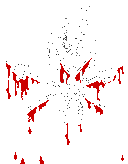




Metallica combined relentless touring and an uncompromising musical approach with a
carefully cultivated air of mystery to achieve enormous commercial success. That it has
become one of rock's most popular groups is made all the more amazing by the fact that not
one of its peer bands which were also playing a sped-
Metallica's roots begin in L.A., where, influenced by a new wave of British metal bands like Saxon and Diamond Head, Lars Ulrich began the search for kindred souls to form his own band in 1980. Guitarist James Hetfield answered Ulrich's newspaper ad, though nothing came of their initial meeting. Two years later, hoping to record a song for a compilation album called Metal Massacre, Ulrich again contacted Hetfield. This time he was ready to play, and with bassist Ron McGovney, they formed Metallica. Guitarist Dave Mustaine joined in April 1982, just after Metallica's first live concert, in Anaheim, Calif.
As a
four-
Like
other underground success stories from the eighties, Metallica succeeded largely without
the aid of radio or MTV exposure through relentless touring and an uncompromising approach
to its music. Case in point: In a decade where high-
Metallica was just as aggressive on record as it was onstage. The New Jersey-
Master of Puppets was not only a musical tour de force; it also brought Metallica increased visibility. A 1986 tour with Ozzy Osbourne was its last as an opening act, but tragedy struck that September, when one of their tour buses flipped over on an icy road in Sweden, killing bass player Cliff Burton. Though devastated, Metallica held auditions in San Francisco less than a month after Burton's death. Five bassists competed to fill the suddenly vacant spot. One, Jason Newsted, knew Metallica's complete repertoire, and when asked by the band which song he'd like to play, he responded, "Any one you like." Newsted played his first show with Metallica in November 1986. As a tribute to Burton, Metallica compiled a home video of its late bandmate's years with the band titled Cliff 'Em All, culled primarily from fans' bootleg videotapes.
… And Justice for
All (1988), Metallica's fourth record, continued to push its hard-
Through its first four albums, Metallica had relied on sheer will and brute force, having pushed the envelope with its music, and letting word of mouth carry it to commercial success. It was time to alter its style somewhat, if not its approach. So 1991's aptly titled Metallica was a refinement. Shorter songs and more concise arrangements were the rule, as the band sought to broaden its appeal and take metal to the mainstream. It worked. The album would go on to spend months on the Billboard charts, selling more than 10 million copies and making the quartet one of the biggest bands in the world.
Although it had changed its sound somewhat, and in doing so achieved massive commercial
success, Metallica remained committed to its dedicated fans. On the long tour in support
of Metallica, the band played a few special surprise concerts for fan-
After a brief hiatus, Metallica again geared up for a big world tour to support Re-Load, released in November 1997. Originally scheduled to kick off March 27, 1998, in New Zealand, the band postponed the opening date after Lars Ulrich's mother Lona died. The band rescheduled to April 17, then began its U.S. onslaught in the summer. After taking the month of August off, it finished up with a handful of West Coast dates in September. 1998 was another good touring year for Metallica; despite the time off, the band earned $24.7 million on the road, making it the 16th most popular concert draw of the year.
Big news for Metallica fans came in March 1999, when bassist Jason Newsted joined gonzo guitarist Ted Nugent at a joint press conference in Pontiac, Mich., for a special announcement. It was there that the long-rumored New Year's Eve show between Metallica and the Motor City Madman became official; the two powers will collide on Dec. 31, 1999, at the Pontiac Silverdome for a millennial blowout. Prior to the big New Year's Eve bash, the band will tour in South America and Europe, make a stop at Woodstock '99 (taking place July 23-25 at Griffiss Park in Rome, N.Y.), then take some time off. Although given Metallica's colorful musical history, there are bound to be a few surprises along the way.
Visit www.olga.net for guitar tabs